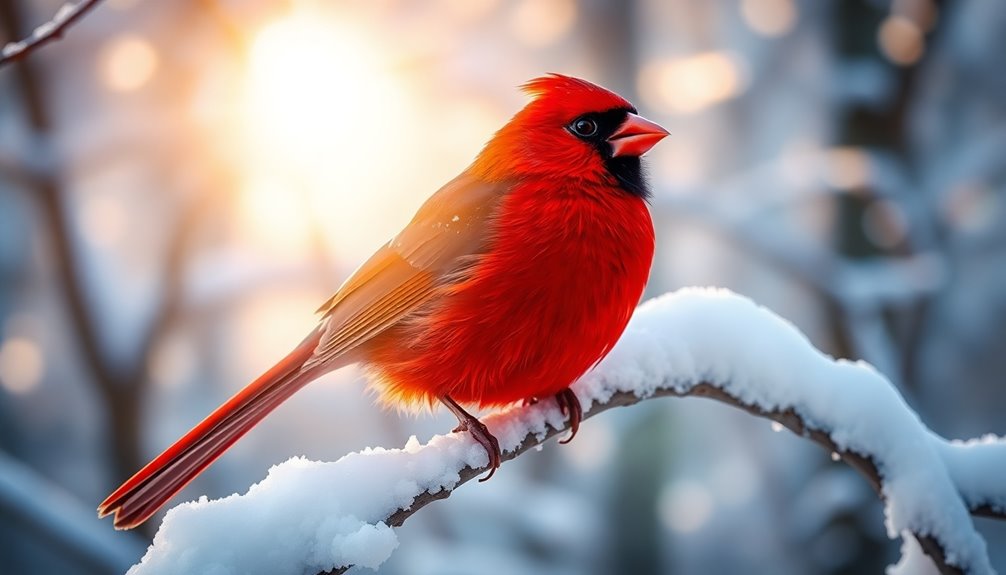Symbolism in "Romeo and Juliet" is really exciting! It shows deep themes like love and conflict. For instance, poison symbolizes how the feuding families create destruction and despair. The light and dark imagery highlights love's beauty against the chaos of their families. Juliet's sleeping potion represents her desperate desire to escape unwanted choices, while the tragic outcomes show how small decisions can lead to big consequences. Each symbol adds layers to the story, making it even more engaging. So, as you explore more, you'll uncover even more fascinating symbols and what they mean in this unforgettable tale!
Key Takeaways
- Poison symbolizes the destructive impact of the Montague-Capulet feud, illustrating moral decay and desperation in Verona.
- The sleeping potion represents Juliet's desperation to escape societal pressures and avoid an unwanted marriage, leading to tragic consequences.
- Light and darkness symbolize the fleeting nature of love, with light representing hope and purity against the chaos of family feuds.
- Flowers symbolize the transient beauty of love, highlighting how romantic connections bloom and wither, reflecting the inevitable tragedy of the lovers' fate.
- The theme of fate vs. free will is underscored by characters' choices, ultimately leading to irreversible consequences and reinforcing the sense of predetermined tragedy.
Character Relationships

In "Romeo and Juliet," the relationships between characters are pivotal in showcasing the intensity of youthful passion and the complexities of love. You see this clearly in Romeo and Juliet's whirlwind romance. They fall in love at first sight, showing just how impulsive young love can be.
Juliet is only 13 years old, making you wonder about her maturity and the pressures society puts on young people when it comes to love and marriage.
Romeo's feelings for Rosaline before he meets Juliet highlight another side of love—unrequited love. His infatuation with Rosaline makes his quick switch to Juliet seem fickle, yet it captures that youthful desire to be in love.
When you look at Romeo's friendship with Mercutio, it contrasts sharply with Tybalt's hostility. This shows how character relationships can be both supportive and adversarial.
The Nurse adds another layer, acting as Juliet's confidante. She provides humor and helps Juliet secretly connect with Romeo, complicating family dynamics.
Through these relationships, you really get a sense of the excitement and challenges of youthful passion in "Romeo and Juliet."
Themes of Violence and Feud
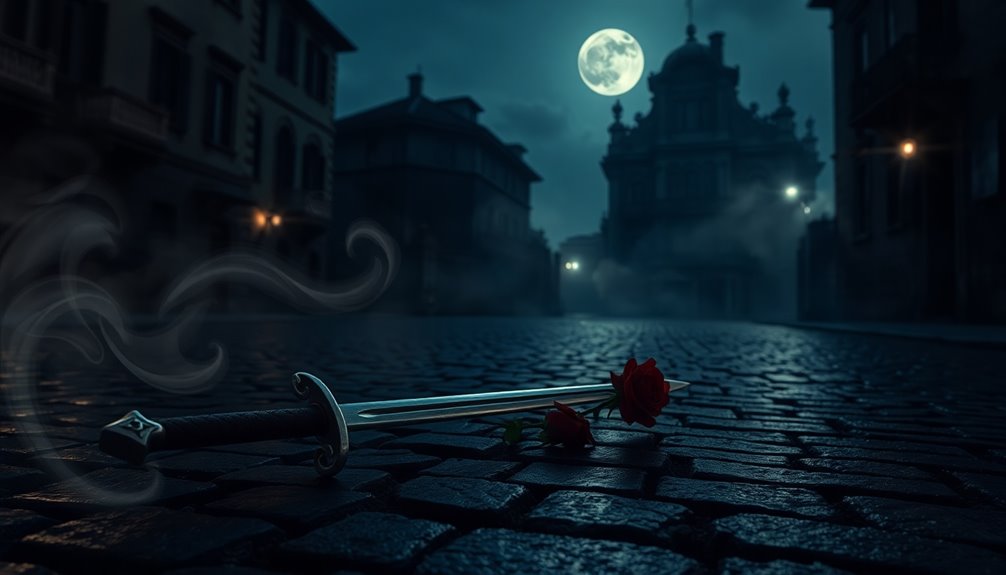
Character relationships in "Romeo and Juliet" not only highlight the complexities of love but also set the stage for the themes of violence and feud that permeate the play. The ongoing conflict between the Capulets and Montagues serves as the heart of the story. This feud drives the tragic events and leads to the heartbreaking deaths of Romeo and Juliet.
When Mercutio is killed by Tybalt, it ignites Romeo's need for revenge, showing how violence continues the cycle of retribution. Tybalt's aggressive behavior is a clear example of toxic masculinity, as he believes that fighting is the solution to his problems. This mindset prevents characters from resolving their conflicts peacefully.
Even the Prince's decree against fighting highlights how futile this rivalry is and the serious consequences it brings to their society. At the very start of the play, a thumb-biting incident shows just how silly the feud can be. It reminds us that small issues can unexpectedly explode into major conflicts.
This theme of violence and feud in "Romeo and Juliet" teaches us about the dangers of letting anger and pride take control.
Symbolism of Poison

Poison plays a pivotal role in "Romeo and Juliet," symbolizing the destructive impact of the feud between the Montagues and Capulets. You can see how poison represents both the tragic fate of the lovers and the chaos around them. When Romeo buys poison from the apothecary, it shows his desperation. It also reflects the moral decay in Verona, where love is overshadowed by violence and death.
Juliet's sleeping potion highlights how good intentions can lead to terrible outcomes. She wants to escape reality, but this decision brings about unintended consequences. You can feel the intensity of Juliet's love as she plans to join Romeo in death through poison, showing how love can drive people to make drastic choices.
The tragic ending, marked by the use of poison, illustrates how something that seems harmless can transform into an agent of destruction. This powerful symbol reminds us how emotions and conflict can twist even the simplest things.
In "Romeo and Juliet," poison symbolizes the tragic fate that awaits these star-crossed lovers and the destructive nature of their families' feud.
Fate vs. Free Will
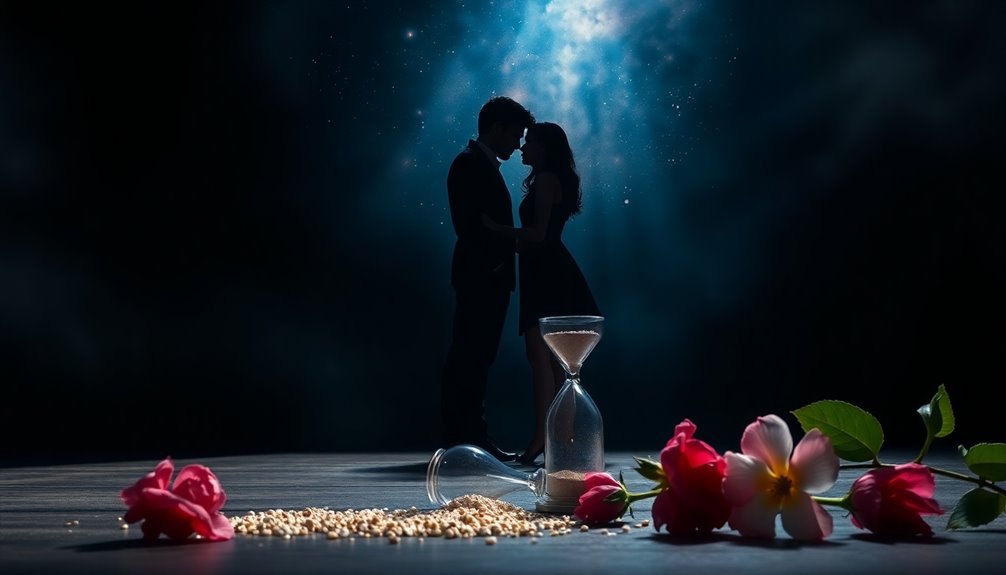
Shakespeare's "Romeo and Juliet" presents a striking exploration of fate versus free will, showing how the characters' lives are shaped by both cosmic forces and personal choices. The famous phrase "star-crossed lovers" hints that Romeo and Juliet's tragic fate is already written in the stars. This idea suggests that no matter what choices they make, their end is inescapable.
Throughout the play, characters like Friar Lawrence try to change their fate. For example, he gives Juliet a potion to help her escape her situation. However, these choices often lead to disastrous consequences, proving that fate can overpower our best intentions.
You'll notice that Romeo and Juliet constantly wrestle with their choices, trying to assert their own paths. Yet, their decisions often align with the tragic fate that looms over them, especially Romeo's impulsive actions driven by passion.
Ultimately, the play wraps up with their heartbreaking deaths, reinforcing the idea that despite their desires and choices, their fates were sealed by the long-standing feud and societal pressures.
It makes you wonder just how much control we really have over our own destinies!
Light and Darkness

Illuminating the themes of love and tragedy, the symbolism of light and darkness in "Romeo and Juliet" powerfully contrasts the innocence of youth with the chaos of family feuds. Here are three key points to contemplate:
- Light symbolizes purity: Romeo describes Juliet as a bright light, showcasing her beauty and goodness. This love shines brightly amid the darkness around them.
- Darkness represents chaos: Characters like Lord Capulet appear in night scenes, symbolizing the violence and turmoil of the family feud. This chaos overshadows the young lovers' happiness.
- Interplay of love and tragedy: Throughout the play, moments of joy quickly turn into sorrow. The love between Romeo and Juliet is often caught in the shadows of conflict.
Prince Escalus, reflecting on the deaths of the lovers, laments how their love was dimmed by the dark feud.
Shakespeare masterfully uses the contrast of light and darkness to deepen the emotional experience of the characters. Their love shines brightly, yet it's constantly threatened by the surrounding chaos.
This powerful symbolism invites you to feel the intensity of their love and the tragedy that unfolds.
Silver and Gold
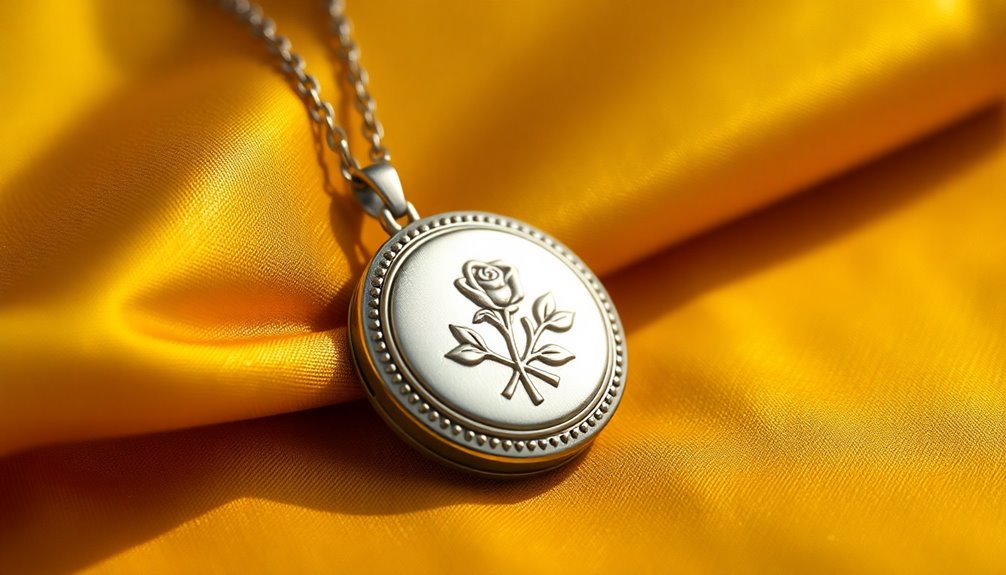
In "Romeo and Juliet," the contrasting symbols of silver and gold reveal deeper themes surrounding love and materialism. Gold often represents materialism and greed, especially in the feud between the Capulets and Montagues. This rivalry, fueled by pride and wealth, shows how destructive these values can be. When Romeo compares gold to poison, he emphasizes his disdain for superficial riches. He believes that real love and genuine connections are far more valuable.
On the other hand, silver symbolizes love and beauty throughout the play. This precious metal enhances the romantic themes, reminding you that true affection is more important than any amount of wealth. Musical references to silver add an enchanting touch, connecting love's beauty to the characters' tragic stories.
Sadly, both families plan to erect golden statues of Romeo and Juliet after their deaths. This decision highlights a failure to learn from their tragic love story, reducing it to mere material worth.
In this way, silver and gold serve as powerful symbols, illustrating the contrast between genuine love and the empty pursuits driven by greed. Ultimately, love shines brightest when it's valued over gold.
Blossoms of Tragedy
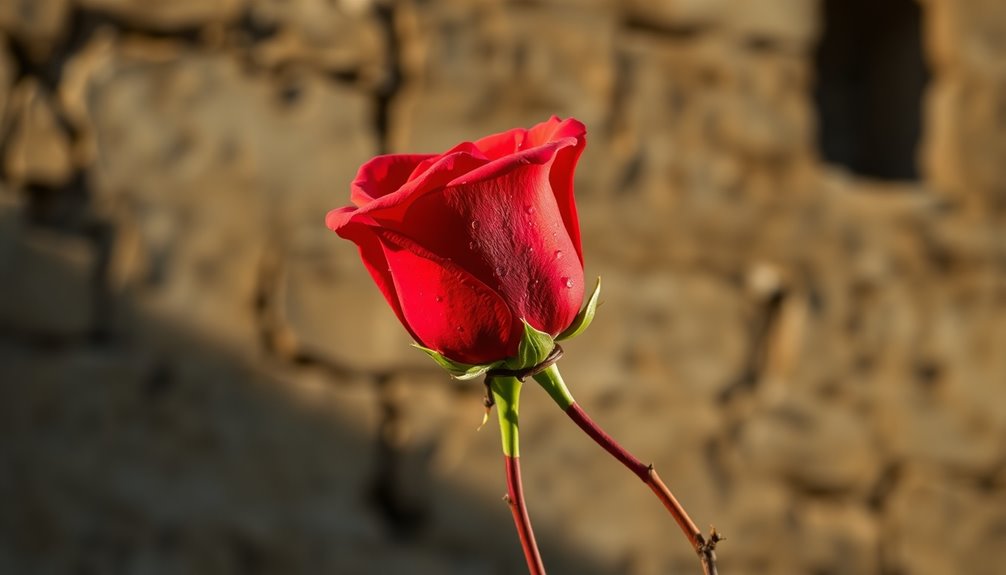
Blossoming throughout "Romeo and Juliet," floral symbolism captures the essence of love's beauty and its tragic temporality. Flowers represent the joy of love but also hint at the sorrow that follows. Here are three key ways flowers symbolize this duality:
- Juliet's Love: Her love is like a budding flower, full of purity and potential.
- Romeo as a Rose: He's compared to a rose, beautiful and romantic, yet this foreshadows the tragedy that awaits.
- Transformation of Flowers: Juliet's bridal flowers turn into funeral flowers, symbolizing how quickly joy can turn to sorrow.
Throughout the play, you see how flowers represent the fleeting nature of love. As the characters experience happiness, it's always shadowed by the inevitability of tragedy.
This contrast shows that while love can be beautiful, it's often temporary. Just like flowers bloom and wither, so does their relationship.
Literary Devices and Motifs

Throughout "Romeo and Juliet," Shakespeare masterfully weaves various literary devices and motifs that enhance the play's themes and emotional depth. One of the most powerful devices he uses is foreshadowing. From the very beginning, the prologue introduces us to "star-crossed lovers," hinting at the tragic fate awaiting Romeo and Juliet. This creates a sense of anticipation as you read.
Another important motif is the symbolism of light and dark. Light represents the beauty and purity of Romeo and Juliet's love, while darkness often symbolizes the violence and chaos surrounding them. When they first meet, Romeo describes Juliet as a source of light, showing how their love shines brightly amid the turmoil.
Time also plays an essential role in the story. The urgency of their relationship highlights how quickly love can blossom and fade.
Shakespeare reminds us that time is both a gift and a thief in their tragic tale.
Emotional Escape Through Potions
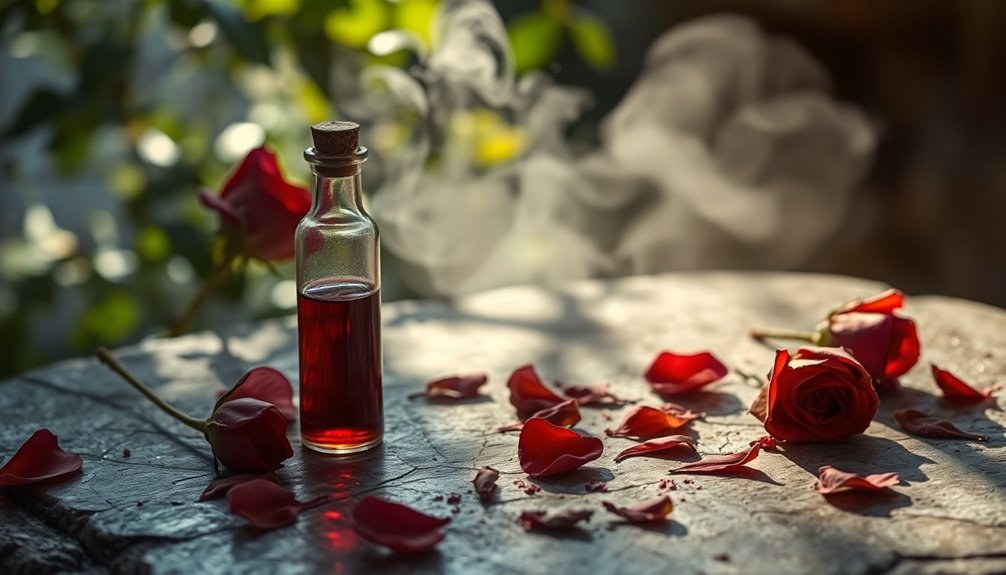
In "Romeo and Juliet," potions become a way for characters to escape their emotional pain.
When Juliet takes the sleeping potion, she's desperately trying to avoid a future without Romeo, and that choice shows just how far she'll go for love.
However, these decisions lead to irreversible consequences, reminding us that trying to escape reality can sometimes make things even worse.
Desperation for Relief
Desperation often drives people to seek immediate relief from their emotional turmoil, and in "Romeo and Juliet," potions become powerful symbols of this struggle. You can see how the characters' choices lead them down a troubling path.
Here are three key points about potions in the play:
- Juliet's Sleeping Potion: She uses it to escape an unwanted marriage to Paris, hoping to reunite with Romeo.
- Romeo's Poison: He chooses poison over living without Juliet, showing the depth of his love and desperation.
- Unintended Consequences: The potions symbolize how quickly a desperate decision can spiral into tragedy.
Shakespeare uses these potions to highlight the characters' emotional pain. Juliet's choice reflects her desperation, but it also leads to misunderstandings with Romeo.
His decision to take poison illustrates how love can drive someone to extreme actions. While potions seem like a quick solution, they often result in dire consequences.
This theme reminds us that seeking relief isn't always the best path. Instead, it shows how emotions can intertwine with fate, leading to outcomes that are both tragic and irreversible.
Irreversible Consequences
Potions in "Romeo and Juliet" symbolize the irreversible consequences that arise from the characters' desperate attempts to escape their emotional turmoil. When Juliet takes Friar Lawrence's sleeping potion, she's trying to avoid marrying Paris. Instead, this choice sets off a tragic series of events that leads to her and Romeo's deaths. It's a powerful reminder that escape can have dire consequences!
Check out the table below to see how potions play a role in the story:
| Character | Potion Used |
|---|---|
| Juliet | Sleeping potion to avoid Paris |
| Romeo | Poison to join Juliet in death |
| Friar Lawrence | Creates the potion for Juliet |
| Paris | Unaware of Juliet's true fate |
| Capulet | Forces Juliet into an unwanted marriage |
Juliet's act of rebellion gives her some control, but it also leads to tragic miscommunication. When Romeo finds Juliet seemingly dead, he turns to poison. This illustrates how their emotional escapes through potions bring about fatal outcomes. In the end, their attempts to change their fates lead only to tragic consequences.
Emotional Pain Escape
The quest for emotional escape drives the characters in "Romeo and Juliet" to seek out potions as a means to alleviate their suffering. Here are three key moments that showcase this theme:
- Juliet takes Friar Lawrence's sleeping potion to avoid marrying Paris.
- Romeo buys poison, desperate to escape the pain of losing Juliet.
- Their attempts to find peace ultimately lead to tragedy.
Juliet's choice to drink the potion shows just how much emotional pain she's in. She feels trapped by her family and society, and the potion seems like her only way out.
On the other hand, Romeo's decision to use poison highlights his intense grief. He believes that without Juliet, life isn't worth living.
While these potions offer a temporary escape, they lead to disastrous outcomes. The characters' attempts to find solace ironically deepen their suffering.
Instead of healing, their choices lead to irreversible consequences, marking a tragic end for both lovers. The potions symbolize the lengths people go to escape emotional pain, reminding us that sometimes seeking relief can bring about even greater heartache.
Family Feud Influence

How does the long-standing feud between the Montagues and Capulets shape the lives of Romeo and Juliet? This feud is like a dark cloud looming over their love. Family loyalty pulls them in different directions, forcing them to choose between their hearts and their families. You can see how this conflict drives their actions, often pushing them to make tough decisions.
Tybalt's fierce anger shows how the feud can lead to violence, creating a world where misunderstandings thrive. Each clash between the families adds tension and danger, complicating the budding romance of Romeo and Juliet. Their love, bright and hopeful, is shadowed by the tragic consequences of their families' hatred.
When Romeo and Juliet meet their untimely end, it reveals the futility of the feud. Their love, which could have united the Montagues and Capulets, instead leads to heartbreak. In their tragic deaths, both families finally see how pointless their fight has been.
Their love transcends family loyalty, showing that sometimes, love can break down walls—even if it comes at a steep price.
Frequently Asked Questions
What Does Day Symbolize in Romeo and Juliet?
In "Romeo and Juliet," daylight symbolizes hope and love.
When you think of their bright moments together, like their first meeting, you can feel the joy of their connection. Daylight represents innocence and the beauty of their relationship, contrasting with the darkness of the family feud.
But as the story unfolds, you see how darkness sneaks in, showing the dangers they face. This mix makes their love all the more powerful and tragic.
What Is an Example of Symbolism in Shakespeare?
Did you know that Shakespeare used symbols to make his stories even more exciting?
For example, in "Macbeth," blood symbolizes guilt. When Macbeth sees blood on his hands after committing a crime, it shows how deeply troubled he is.
This powerful image helps you understand his feelings and the consequences of his actions.
Shakespeare's clever use of symbolism adds layers to the characters and their journeys, making his plays unforgettable and relatable.
What Do the Plants Symbolize in Romeo and Juliet?
In "Romeo and Juliet," plants symbolize different aspects of love and life.
For example, Juliet's love is like a delicate flower, beautiful yet fragile. The rose represents passionate love but also has thorns, showing that love can bring pain.
The poison symbolizes how love can lead to tragic endings. When Juliet's bridal flowers turn into funeral flowers, it captures the shift from love to loss.
These symbols remind us that love is complex and powerful!
What Does Romeo and Juliet's Death Symbolize?
Romeo and Juliet's death symbolizes the sad results of their families' long feud.
Their tragic end shows how anger can destroy love and innocence. It highlights how impulsive decisions can lead to irreversible harm.
Both families find peace after the loss, but it's a bittersweet moment filled with sorrow.
Their story teaches us that love can be powerful, yet sometimes, it feels powerless against the struggles of the world around them.
Conclusion
In "Romeo and Juliet," the beauty of love shines brightly against the darkness of hate. You see how love can be both joyful and tragic, uniting two hearts while tearing families apart. The symbols, like poison and light, show us the powerful choices we make. As you explore these themes, remember how love and conflict dance together, creating a story that's exciting yet heartbreaking. Shakespeare teaches us that every choice has a ripple, shaping our destinies forever.


